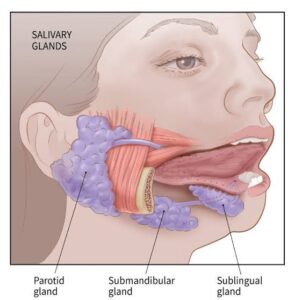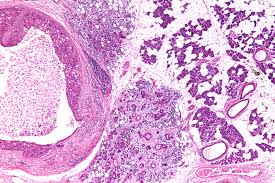
Salivary duct carcinoma is a rare, typically highgrade malignant epithelial neoplasm composed of structures that resemble expanded salivary gland ducts. A low-grade variant exists. Incidence rates vary depending upon the study cited. In the AFIP files, salivary duct carcinomas represent only 0.2 per cent of all epithelial salivary gland neoplasms. More than 85 per cent of cases involve the parotid gland and approximately 75 percent of patients are men. The peak incidence is reported to be in the seventh and eighth decades of life.
Clinical Features.
Parotid swelling is the most common sign. Facial nerve dysfunction or paralysis occur in over one-fourth of patients and may be the initial manifestation. The high-grade variant of this neoplasm is one of the most aggressive types of salivary gland carcinomas and is typified by local invasion, lymphatic and hematogenous spread with poor prognosis.
Histologic Features.

The infiltrative tumor elements are typically composed of clusters of tumor cells that may have small lumina or cribriform arrangements, but solid, irregularly shaped tumor cell aggregates are frequently present. The neoplastic epithelial cells are cuboidal and polygonal with a moderate amount of eosinophilic cytoplasm and are accompanied by a dense fibrous connective tissue stroma that may be hyalinised in some areas. Invasion of the nerves and blood vessels is frequent in addition to infiltration of salivary gland lobules and extrasalivary gland tissues, such as fat, muscle, and bone. Mucicarmine and Alcian blue stains are generally negative, except, perhaps, for a small amount of luminal staining. Immuno- histochemical and ultrastructural studies have identified ductal cells but no myoepithelial cells.
Treatment and Prognosis.
Salivary duct carcinoma is a high-grade malignancy that must be treated aggressively. Complete local excision with radical neck dissection and postoperative radiation therapy seems to offer the maximum benefit for the patient.